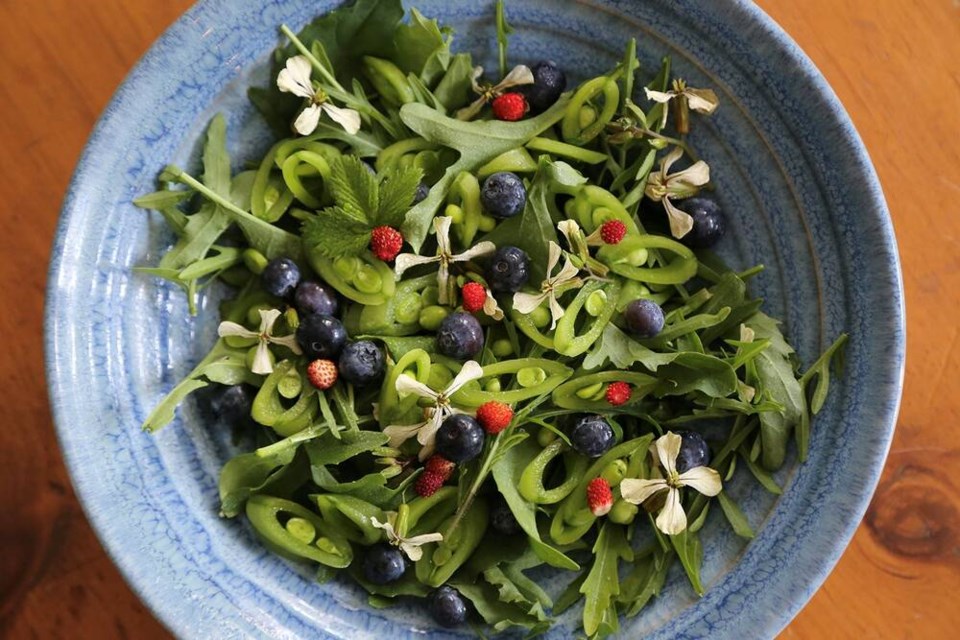This week’s sunny weather seduced me into the garden to sweep the old greenhouse benches and early-start some peas. Indeed it is cold, but the algae-hazed glazing will provide protection from wind and rain, and the stone floor will absorb and store solar energy from increasingly longer days.
Peas are traditionally spring or cool weather crops, but in our garden they are ever-present from March through the first frosts of late October. They change locations seasonally from full-spring sun to part-summer sun, back to full sun again in the fall.
Peas can be planted strategically and repeatedly throughout the growing season – like succession planting, only tactical. The trick is to mimic spring conditions as much as possible, by manipulating sunlight hours, soil moisture and air temperature, to suit the temperate preferences of peas.
Peas are easy to grow, prepare and preserve in thousands of ways. We plant both popular types – sugar (or snap) peas, and shelling peas. Sugar peas can be enjoyed whole at all stages of development, pod and all, until they pass the ripe stage and become woody and starchy. We also love old-fashioned shelling type peas, which produce inedible (typically) pods of fat, sweet green peas.
Interestingly, many shelling peas can be eaten whole when young. I snack on super sweet and crunchy whole pods every few days for as long as they remain tender. Typically, once the pods grow to about 50-per-cent maturity, their armour toughens up to protect on-board cargo.
We eat sugar snap peas like candy, including them with carrot and cucumber sticks in lunches with hummus. We slice them on the diagonal into salads, stir fries and soups. We whizz them into fresh juices and smoothies.
In our garden, we share peas with the birds. Red-eyed towhees and sparrows are big time pea stealers. They arrive just as the peas are at the peak of ripeness, then sit patiently, pecking away at the pod until they have unzipped it enough to pull out the peas. It’s delightful to witness, the puffy and wobbly babies in particular, as they work away for their supper. I could never shoo them off. Certainly, they are as grateful for the peas as I am for the entertainment.
This year, on obelisk trellises, we are growing exotic frilly-topped Parsley snap peas, Super Sugar snaps, Avalanche snow peas and an experimental purple snow pea from Row 7 Seeds. Against a tall and sunny fence, we will grow hearty and prolific Alderman (a.k.a. Tall Telephone) and Alaska shelling peas on jute lines, and for my mother-in-law’s container gardens we will start tiny Little Marvel shelling peas and Dwarf Grey sugar snaps.
To involve children in gardening and growing food, experiment with peas, and plant two or three times throughout the season. Tiny hands can sink three or four well spaced seeds into deep 10-centimetre-wide pots, so they can be popped out together as a tidy unit (without damaging the roots) and planted at the base of a trellis upright or string – easy peasy!
It is beneficial always to leave pea roots in the ground after harvest – simply trim off the spent stalks for composting. Pea plants, like other legumes, sequester atmospheric nitrogen below ground. When fortified roots are left intact to decompose naturally, they nourish the entire soil-food web.
Shelling peas are an ideal food-as-medicine snack food in my book. The wee green orbs offer a superior variety of essential vitamins and minerals, are high in fibre, protein and polyphenol antioxidants. A bonus: they come wrapped in their own beautiful and compostable container.
Laura Marie Neubert is a West Vancouver-based urban permaculture designer. Follow her on Instagram @upfrontandbeautiful, learn more about permaculture by visiting her Upfront & Beautiful website or email your questions to her here.
For a taste of permaculture, watch the video below:




.jpg;w=120;h=80;mode=crop)